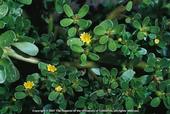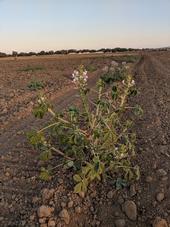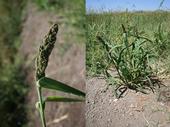- Author: Rachael Freeman Long
- Author: Morgan P. Doran
- Author: Robert Poppenga
- Author: Daniel H. Putnam
- View More...

From the Alfalfa & Forage News blog (April 29, 2022)
Vetch (Vicia spp.) is growing like a weed everywhere this year, carpeting our hills with great swaths of purple flowers.
What is vetch? There are several species that are commonly grown as crops, cover crops or weeds (see list at the bottom). Vetch is a winter-hardy legume that's favored by early fall rains, which we had lots of last October (5.5-in in 24-hr in Sacramento). Vetch is also a nitrogen-fixing...
- Author: Guy B Kyser

This has been a big year for purslane at the UC Davis farm. Common purslane (Portulaca oleracea) is a succulent summer annual weed with fleshy leaves and rubbery-looking stems. Native to Eurasia, or maybe Africa, purslane arrived in the Americas with the first Europeans to settle here. It is a common weed in row crops worldwide.
Purslane is a tasty vegetable, either raw or cooked, and sometimes appears in farmer's markets and grocery stores. It is reported to be high in omega-3 fatty acids.
It's also a royal pain in the neck as a crop weed. Each plant produces thousands of tiny, long-lived seeds. The brittle stems make it difficult to pull or hoe, and stem fragments left on the soil will readily re-root. I once...
- Author: Guy B Kyser
- Author: Mohsen Mesgaran

Dr. Mohsen Mesgaran, who joined the Weed Science Group this year as our weed ecophysiologist, found this plant growing on the research farm at UC Davis.
African spiderflower is a summer annual broadleaf plant in the caper family (Cleomaceae), growing up to 3 ft tall and wide. The flowers are white, somewhat tubular, with long red-to-orange stamens (see photos below). Interestingly, African spiderflower plants have three types of flowers - male, female, and hermaphroditic.
We have no idea how this plant got here. It is native to Africa, where the leaves are used as a vegetable; it is now widespread and invasive in many tropical to subtropical parts of the world. The USDA
- Author: Gale Perez

This just in from the UC Rice blog (http://ucanr.org/blogs/riceblog/). The author is Luis Espino, UC Cooperative Extension Rice Farm Advisor in Colusa-Glenn-Yolo Counties.
Japanese Millet
August 26, 2013
Japanese millet is not a weed of rice in our area. However, a PCA recently noticed it in an organic rice field. Japanese millet is in the same genus as our common watergrasses, and looks similar, but is much more robust. It seems to grow well under flooded...
- Posted by: Gale Perez
- Author: Richard Smith

Cilantro was produced on 5,543 acres in Monterey and Ventura Counties in 2011. The production of cilantro has shifted to high density 80-inch wide beds and a large proportion is now mechanically harvested. Hand weeding high density beds is very expensive and reduces the economic viability of this crop. As a result, there is a need for excellent weed control. Two broadleaf herbicides were registered on cilantro: Prefar and Caparol. Prefar was registered for a number of years and provides good control of a number of key weeds in cilantro such as purslane, lambsquarter and pigweed. Caparol was registered in 2012 and provides good weed control of a wider spectrum of weeds including the nightshades, shepherd’s purse, sow thistle,...


